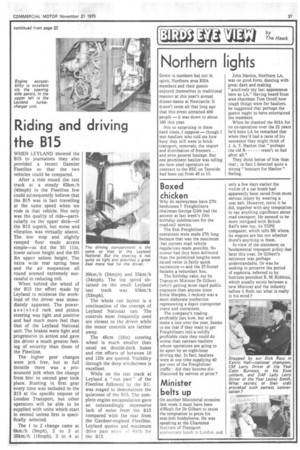Riding and driving the B15
Page 43

If you've noticed an error in this article please click here to report it so we can fix it.
WHEN LEYLAND showed the B15 to journalists they also provided a recent Daimler Fleetline so that the two vehicles could be compared.
After a ride round the test track at a steady 65km/h (40mph) in the Fleetline few could subsequently believe that the B15 was in fact travelling at the same speed when we rode in that vehicle. Not only was the quality of ride—particularly on the upper deck—of the B15 superb, but noise and vibration was virtually absent. The low step and slightly ramped floor made access simple—as did the 5ft 1 lin, lower saloon height and the 6ft 3in upper saloon height. The extra wide rear spring base and the air suspension all round seemed extremely successful in reducing roll.
When behind the wheel of the B15 the effort made by Leyland to minimise the workload of the driver was immediately apparent. The powerassis t ed rack and pinion steering was light and positive and had much more feel than that of the Leyland National unit. The brakes were light and progressive in action and gave the driver a much greater feeling of security than those of the Fleetline.
The higher gear changes were jerk free, but at full throttle there was a pronounced jerk when the change from first to second gear took place. Starting in first gear every time was included in the B15 at the specific request of London Transport, but other operators will be able to be supplied with units which start in second unless first is specifically selected.
The 1 to 2 change came at 8km/h (5mph), 2 to 3 at 26km/h (16mph), 3 to 4 at 39km/h (24mph) and 55km/h (34mph). The top speed obtained on the small Leyland test track was 85km/h (53mph), The whole cab layout is a continuation of the concept of Leyland National cab. The controls most frequently used are closest to the driver while the minor controls are farther away.
The 46cm (18in) steering wheel is much smaller than usual on double-deck buses and rim efforts of between 10 and 121b are quoted. Visibility through the deep windscreen is excellent.
While on the test track at Leyland a "run past" of the Fleetline followed by the Bit, was staged to demonstrate the quietness of the 815. The complete engine encapsulation gave an outstandingly impressive lack of noise from the B15 compared with the roar from the Gardner-engined Fleetline. Leyland quotes and maximum drive past noize of (-'1) for the B15.








































































































